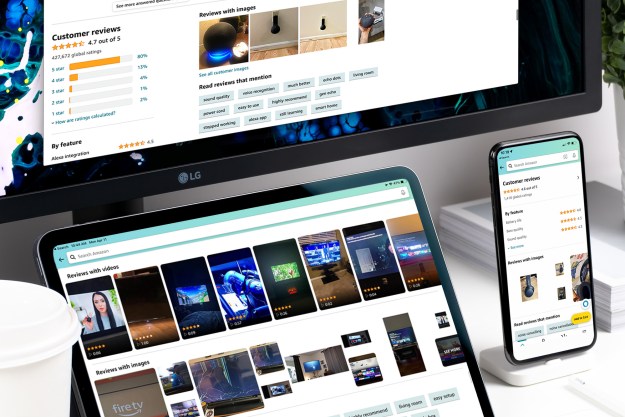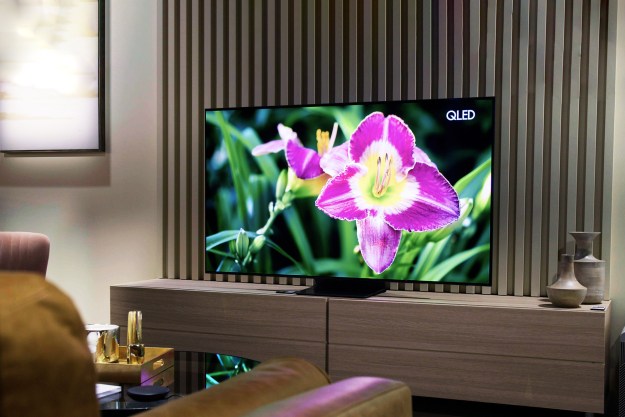“Olive has come up with one of the best devices on the market today.”
- Easy to use for normal operation; excellent sounding; supports lossless formats
- Only supports 16-bit tracks; takes a while to load music onto the hard drive
Summary
At times, it helps to have curious friends with deep pockets. After reading about the Olive Symphony, I was salivating to try it. But at $899 ($1099 for the Musica with a 160GB hard drive), it was well beyond my limited budget. However, a friend of mine with adventurous spirit and money invested in one, and while staying with him, I persuaded him to let me test drive the machine.
As the name implies, it’s aimed at classical music fans who want to fully embrace the digital age. However, it works for everyone, whether your tastes are for Wagner or Weezer,. Standing as a piece of hi-fi equipment, it’s the kind of thing music aficionados put together in their minds during long, sleepless nights. From playing CDs to ripping and burning them, to hooking up with your portable player, the Symphony can do it all–and more. Granted, it’s not the first piece of stereo equipment with a hard drive (80 GB on the Symphony), it’s undoubtedly the best and easiest to use, packed into a single component that will look right at home with the rest of your stereo equipment.
Features and Design
The Olive Symphony possesses the usual controls you’d find on a CD player, in addition to a two-level jog shuttle and four buttons on the right for menu navigation (if that’s reminiscent of the iPod, it might be due to the fact that the company making Olive is a subsidiary of a German firm that provides products for Macintosh computers), with everything appearing clearly on a backlit screen. Learning is intuitive and easy, requiring only a small learning curve and glances at the manual.
So, how does it work? Put a CD in the transport, and the Play button begins to glow. Press it, and there’s a much better-than-average chance the name of the disc and track will appear on the screen, thanks to a built-in two million track database (although, to be fair, it didn’t work on some of my more obscure world music recordings). Want to add the disc to the Symphony’s hard drive? All you do is press a single button. Best of all, especially for audiophile classical buffs, you have your choice of format, all in 32-bit processing. There’s the ubiquitous mp3 (from 128-320 kbps), of course, but also uncompressed WAV, AIFF, and the compressed FLAC, all of which are lossless in sound quality. Although the Symphony claims to hold 20,000 tracks on its drive, that’s only in mp3; you’ll only pack on about one-tenth of that in FLAC. Should you want to burn a CD from your tracks, that’s also accomplished with remarkable ease.
And with two USB 2.0 ports at the rear, you can attach external hard drives with your own music to import (easily done by pressing the Import button). That would be ample, but it’s only the beginning. Attach your mp3 player to the USB port, and your music shows up on the Symphony–although it won’t play anything that’s copy-protected, so if you’ve bought a lot from iTunes, you’re out of luck. And you can download tracks from the Symphony directly to your player without needing a computer.
Is that enough? No. It’s easy to see that this was designed by true music-loving nerds. If you still have old vinyl (or even–shudder–cassettes), you can connect your equipment to the symphony, and suddenly every track will be there on the hard drive in a sparkling digital form, with all those clicks and scratches lovingly preserved.
People who keep a lot of music on their computers (I prefer external hard drives, in case of crashes) and use a wireless network at home are in for a treat. Like a geek’s dream, the Symphony has a wireless 802.11g antenna, so you can make it part of your network. Once you’ve done that, the library from your computer shows up on the symphony–and vice versa–and you can see the icon in iTunes (I didn’t try it with my MusicMatch). But unlike your noisy computer, music from the Symphony’s hard drive plays without the background soundtrack of a fan; it’s a fan-less unit. But even if you’re not wireless, you can still hook it into your wired network using the four–that’s right, four–Ethernet connectors at the back. So, you can sit at the keyboard and drag music files back and forth between the computer and Symphony or edit and tag tracks. The manufacturers do supply what looks to be a heady playlist-management program for classical fans. However, it only operates in Mac OSX, and my friend has PCs. But he likes digital radio, and the machine’s Internet connection allows him to access all those thousands of stations broadcasting into cyberspace.
The Symphony can also supposedly stream music to up to five different computers at once. I didn’t test that many, but it worked well, sending different music to each of the house’s three computers–one son listened to Offspring, another Blink 82, while the parents and I relaxed with some old Steeleye Span and a glass of wine.
Image Courtesy of Olive
Testing and Use
At this point, it sounds close to perfect, and its easy operation and sensible manual make most things quite straightforward. But, inevitably, there are downsides. I didn’t have to experience it, but I was told that adding the Symphony to the wireless home network was a slow and painful process–and this from someone who’s very techno-savvy. And unlike ripping a CD on your computer, where it’s immediately available in the library, the Symphony takes a surprisingly long while to process all the information before the music is available.
According to the specs, it’s possible to import Ogg Vorbis files into the Symphony. However, in practice that seemed impossible. They have to be transformed into other formats prior to moving them. And once they’re in the machine, there’s no way to convert them to FLAC–all that has to be done on the computer beforehand, which can make for a few convoluted procedures. And files can only be imported in 16-bit, so make sure they are the correct bit-rate before you import. I accidentally brought in a track in 24-bit, and when I tried to play it found myself listening to white noise–not the most pleasant experience, and it took a while before I figured out the cause.
While it’s primarily a digital music center, the Olive Symphony is also most decidedly a part of your stereo setup, hooking up to your amplifier or receiver via RCA analog or the S/P DIF digital outputs and playing like a normal component with excellent fidelity–especially on expensive systems, where the nuances of a performance and recording can be properly heard and appreciated. You can set the volume level for the Symphony, ensuring all the music it plays will be at that volume, which is useful for quieting some loud passages and enhancing quiet ones, evening out the dynamics.
For those who’d appreciate the Symphony in every room, even those without computers, the company has recently introduced the Sonata, a small wireless receiver that can be hooked up to supposedly 20 stereos throughout the house, each playing a different stream. But at $199 each, it’s a relatively expensive way to spread the sound. Still, a person can dream…
Those with real money to spend can fork out $1099 and buy the Musica. The main differences between it and the Symphony are color (the Musica is silver as opposed to Symphony’s black) and hard drive size (160GB compared to 80GB). From the specs on the company website (http://www.olive.us/), it’s the same machine with a bigger belly.
If you’re thinking of buying a Symphony, but have a large CD collection and can’t face the prospect of ripping disc after disc onto the hard drive, Olive does have a great offer to tempt prospective customers: Order the device from them, ship the CDs to them via Fed Ex, and they’ll rip your entire collection onto the hard drive free of charge. Then they’ll return your CDs along with a fully loaded Symphony or Musica. However, if the amount of music is large enough, it’s going to cost a fair amount in freight, so you might be advised to think twice.
Conclusion
In conclusion, Olive has come up with one of the best devices on the market today. Yes, it’s a bridge between CD component and computer, but it’s well thought out, with enough to please even the most critical mind and ear. Attractive and easy to use, it can appeal not only to those wanting to integrate their digitized music collections with their stereos, but also computer-phobes who want to enter the 21st century. All things considered, the minuses are rather small, especially when weighed against the many things the machine can do. It’s the sort of machine that’s been waiting to happen; all it needed was someone with the imagination to put all of the ideas together in a single box and make them cohesive. Olive might be marketing this to classical music lovers and their high-end audio tastes, but there’s no doubt it works perfectly well for those of us who are a little less highbrow. Testing it was a joy, but also a frustration. Now, I need to find the $899 to afford one of my own.
Pros:
- Intuitive to use
- Excellent sound quality
- Supports multiple streams
- Fan-less design
- Plays lossless formats
Cons:
- Only plays 16-bit files
- Playlist program only works on a Mac
- Difficult to play Ogg Vorbis tracks
Editors' Recommendations
- Beats partners with Emma Chamberlain to debut Studio Buds+ in pink and silver metallic
- Samsung S95C OLED hands-on review: it’s time to get excited
- Edifier MP230 Hands-on Review: The pint-sized, retro Bluetooth speaker brings a vintage vibe
- Sonos Voice Control hands-off review: Now we’re talking
- All the new tech that blew our reviewers away this month





